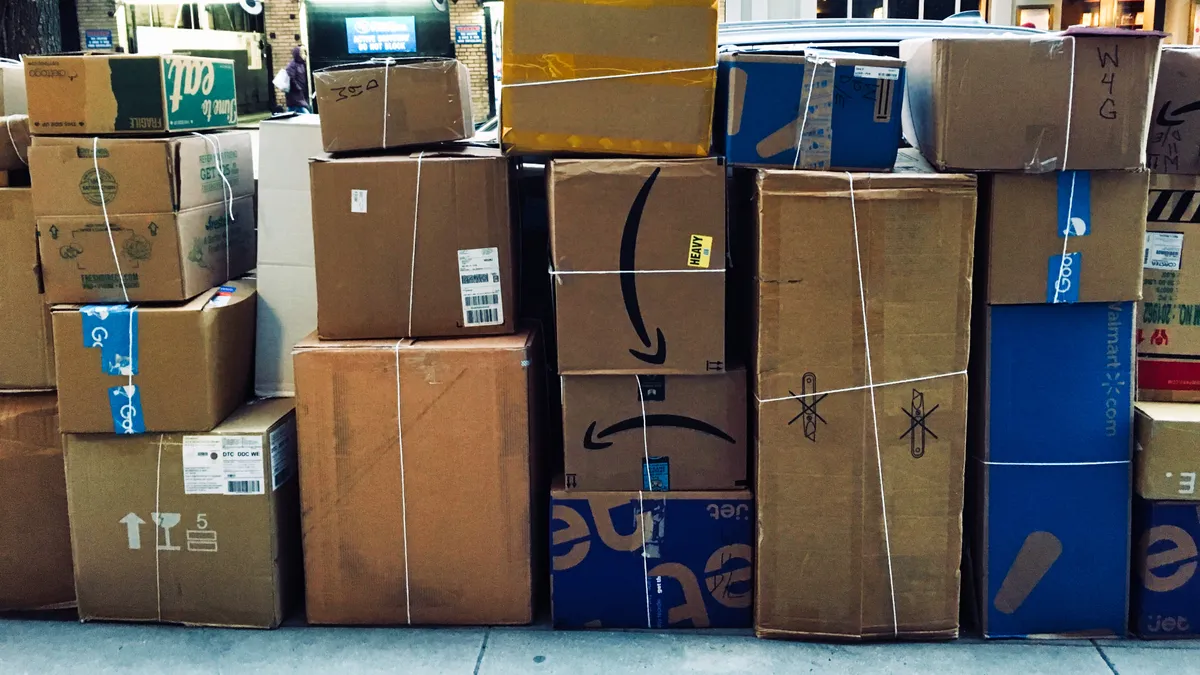In many areas of the country, physical stores are reopening as restrictions set to slow COVID-19 ease. In the meantime, e-commerce has soared.
Last month, non-store sales, mostly conducted through e-commerce, rose 28%, a bright spot in a period when overall retail sales tracked by Retail Dive plummeted 16% year over year, or 17.8% as measured by the federal government. Those non-store sales managed "to capture 19% of overall retail sales; compared to 12% on average the past two years," according to a note from Wells Fargo Economics Group, led by Senior Economist Tim Quinlan.
That picture won't immediately alter even as stores open because shoppers remain wary, analysts say. More than 60% of Americans are worried about lifting restrictions too quickly, with less than a third concerned about not reopening quickly enough, according to a May 5 Monmouth University poll. A third want to move to forestall a deep and prolonged economic downturn, but 56% said public health concerns are more important in deciding when to end the current limits, according to that report.
Unsurprisingly, consumers have gone online for even more shopping than usual, speeding up an existing trend. Digital revenue in April "far outpaced previous years and previous months," according to a report emailed to Retail Dive by digital experience company Episerver. Traffic was up 30% year over year and 15% month over month; conversion rates were up 22% year over year and 18% month over month, with "nominal changes in discounting." And social media delivered, bringing 89% more traffic to retail sites compared to April 2019, according to that report.
But the costs of e-commerce are high, and, in another trend that started before the pandemic, have become more visible, observers say.
"You would think that [fears about shopping in stores] would then lead to big increases in e-commerce, and it has," Nick Egelanian, president of retail real estate development firm SiteWorks, told Retail Dive in an email. "But at what cost?"
Hit to margins
Retailers selling discretionary goods depend on discovery, which is still best accomplished in physical spaces, and April was unkind to those retailers. Apparel sellers in particular saw demand fall off.
"The shutdown of most physical apparel stores, plus the sharp decline in outfits needed for work and leisure contributed to the precipitous drop," GlobalData Retail Managing Director Neil Saunders said in emailed comments. "While there were a few bright spots, most notably from athleisure and comfort clothing, consumers simply turned their backs on fashion in April."
But it's not just apparel. Direct-to-consumer companies, including eyewear e-retailer Warby Parker and grooming brand Harry's, in recent years have accepted that running physical stores or partnering with brick-and-mortar retailers are necessary methods of marketing to their customers. And several, including furniture pure player Wayfair and mostly online mattress brand Casper, have struggled to get into the black.
Even Amazon, which grappled with soaring demand due to the pandemic in the first quarter, saw costs wipe away profits, as it also scrambled to get items to customers in its usual timely fashion. CFO Brian Olsavsky told analysts earlier this month that he couldn't predict when the e-commerce giant's much-touted one-day Prime shipping would resume.
"Amazon dramatically cut their service level, which is especially hard for sellers," Jason Goldberg, chief commerce strategy officer at Publicis Communications, told Retail Dive in an interview. "We noticed they ratcheted up slower shipping incentives and were taking steps to sell less. 'Today's Deals' was gone from their page for a while, and they were amplifying [e-books]. It was a remarkable pivot for someone who's in the business of selling stuff."
When it comes to profits, Walmart didn't run into that level of trouble in its first quarter, although the company acknowledged that it couldn't avoid a hit to margins and profits from the period's ballooning online sales. The retail giant also announced that it is nixing its Jet e-commerce unit in favor of its own flagship site, which benefits somewhat from its ability to leverage stores for online fulfillment as customers themselves take care of the last mile.
That's because in-store pickup of online orders is the "least efficient and least reliable way to get products to consumers," as Neil Stern, senior partner at retail strategy and consulting firm McMillanDoolittle, recently told sister publication Grocery Dive.
Such challenges are now at the doorstep of any retailer ramping up its online channel, according to Egelanian.
"Retailers from grocery stores to Home Depot are seeing surging online orders and curbside pickup, but I doubt that any are making any real profits," Egelanian said. "Store employees spend hours walking store aisles filling orders inefficiently as consumers get the use of free personal shoppers. That's not a sustainable formula."
The constraints have been revealed
E-commerce may be less than ideal for retailers, which must spend more to market to customers, fulfill orders and grapple with the channel's larger number of returns. But consumers are coming to terms with its limits, too, analysts say.
"With a few years of experience in buying online and several painful experiences of having to return the product, consumers realize that e-commerce is not a guarantee of seamless shopping," said Thomai Serdari, a marketing and branding professor at New York University's Stern School of Business, and author of the forthcoming book "Rethinking Luxury Fashion: The Role of Cultural Intelligence in Creative Strategy."
"In two decades of thinking about what technology means to the demand chain, now everyone has a rude awakening to the constraints."

Keith Anderson
Senior Vice President of Product Strategy and Insights, Profitero
It's not just the pain of returns, but also serious concerns about the environmental impact — from the excessive packaging to the need for delivery that clogs city traffic and spikes emissions, she told Retail Dive in an email.
Add to that the pandemic-specific problem of fulfillment workers getting sick, which earned Amazon, in particular, a rash of bad press, according to Keith Anderson, Profitero's senior vice president of product strategy and insights, who said that lower sales margins, while real, are not e-commerce's only problem.
"In two decades of thinking about what technology means to the demand chain, now everyone has a rude awakening to the constraints," he told Retail Dive in an interview. "What it means to people working in the fulfillment centers is getting undeniable as people get sick."
In a trend that was already emerging before the pandemic hit, direct-to-consumer brands or retailers selling online, especially those relying on "someone else's infrastructure," will find it more difficult to get capital or investment, according to Anderson. In short, "e-commerce isn't magic."
"That's not a new idea, but the acknowledgment is new, and it's shocking how quickly it's been revealed," he said. "All of a sudden you have to acknowledge it. There's a new focus on the supply chain, and the economics of e-commerce, and the environmental consequences."




















